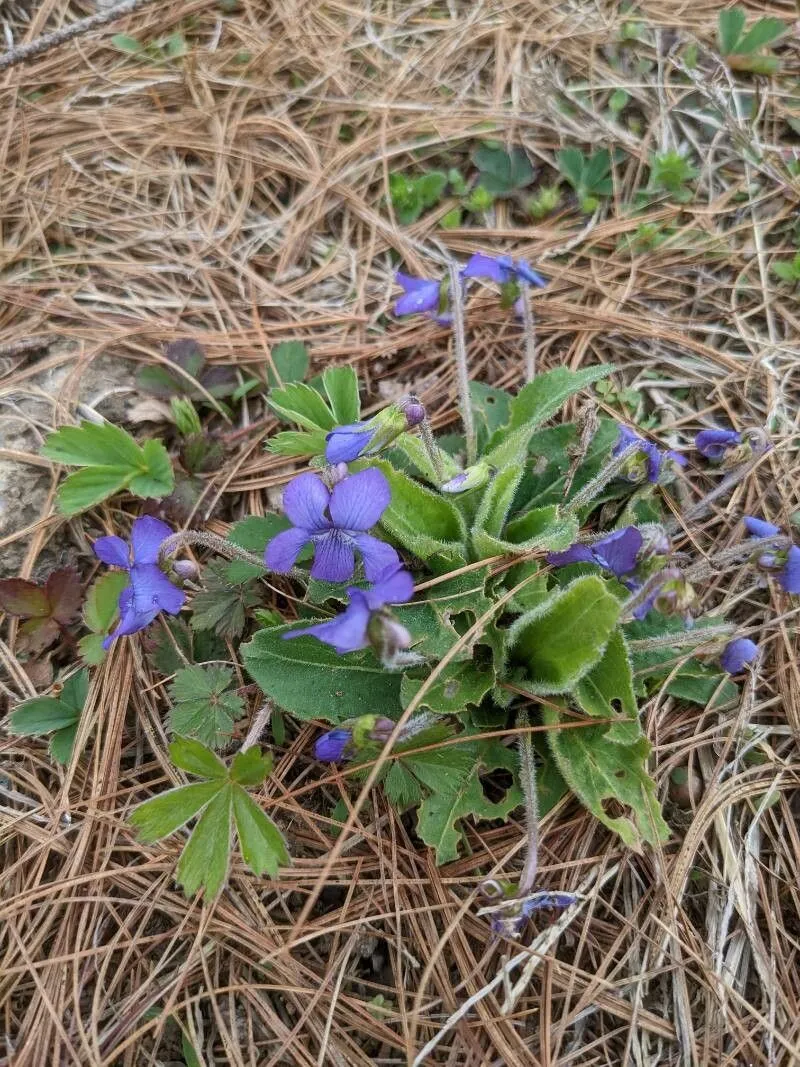
Author: Aiton
Bibliography: Hort. Kew. 3: 287 (1789)
Year: 1789
Status: accepted
Rank: species
Genus: Viola
Vegetable: Unknown
Observations: E. Canada to C. & E. U.S.A.
Fringed violet, scientifically known as Viola sagittata, is a charming wildflower that has captured the attention of botanists and plant enthusiasts alike. This perennial herb can be found widely distributed across Eastern Canada, as well as the central and eastern regions of the United States.
Identifiable by its distinctive heart-shaped leaves, which bear the characteristic pointed tips resembling arrowheads, Viola sagittata thrives in its natural habitats of meadows, woodland edges, and open fields. The plant’s common name, “fringed violet,” pays homage to its delicate, slightly fringed petals that grace its vibrant, violet-colored flowers.
Belonging to the Violaceae family, the fringed violet was first comprehensively described in 1789 by the botanist William Aiton in Hortus Kewensis, a catalogue of plants cultivated in the Royal Botanic Garden at Kew. Its classification within the extensive Violaceae family marks it as a relative of many other well-known violets, each celebrated for their beauty and ecological importance.
In terms of morphology, the fringed violet grows from 10 to 30 cm in height. Its foliage consists of basal rosettes, from which the flowering stems arise. The blooms, appearing in early spring to summer, are not just visually appealing but are also vital for local pollinators, particularly various species of bees that rely on them for nectar.
The fringed violet’s adaptability to various soil types and conditions makes it a resilient species, often found in both moist and dry environments. However, it favors well-drained soils and partial to full sunlight, which maximizes its flowering potential and overall vigor.
Despite its relatively common presence in its native range, the fringed violet is a cherished addition to native plant gardens and ecological restoration projects. It provides not only aesthetic appeal but also supports biodiversity by serving as a host plant for caterpillars of certain butterfly species.
For anyone interested in cultivating fringed violet in their garden, it’s advisable to mimic its natural habitat by ensuring adequate sunlight and well-drained soil conditions. This would help to recreate the ecological niche the plant thrives in, offering a glimpse of the delicate beauty of North America’s wild flora.
In summary, Viola sagittata, or fringed violet, stands as a testament to the understated beauty and ecological significance of native wildflowers. Its historical documentation by Aiton mirrors its longstanding appreciation in botanical circles, while its presence in the wild highlights the ongoing importance of plant conservation and habitat preservation.
Eng: arrow-leaved violet, arrowhead violet, arrowleaf violet, fringed violet
Swe: pilviol
Fra: violette sagittée
En: Fringed violet, Arrowhead violet, Arrowleaf violet, Arrow-leaved violet
Fr: Violette sagittée
Sv: Pilviol
Taken May 26, 2020 by Amanda Huggenkiss (cc-by-sa)
Taken May 6, 2022 by Don Sadowsky (cc-by-sa)
Taken May 2, 2019 by Lauren Dillon (cc-by-sa)
Taken May 11, 2022 by Abigail Grunewald (cc-by-sa)
Taken May 11, 2022 by Emmy Kegler (cc-by-sa)
Taken Apr 11, 2021 by 志埜杜 (cc-by-sa)
Taken May 3, 2020 by Name Fake (cc-by-sa)
Taken May 31, 2022 by 淳一 橘川 (cc-by-sa)
Taken May 12, 2022 by Cedar Bridge Botanicals (cc-by-sa)
Taken Mar 30, 2022 by steven dowell (cc-by-sa)
Taken Jan 1, 1900 by EOL − Smithsonian Institution, National Museum of Natural History, Department of Botany (cc-by-nc-sa)
Taken Jan 1, 1900 by EOL − John Hilty (cc-by-nc)
Taken Jan 1, 1900 by EOL − Cooper, G.A. (cc-by-nc-sa)
Taken Jan 1, 1900 by EOL − Cooper, G.A. (cc-by-nc-sa)
Taken Jan 1, 1900 by EOL − Cooper, G.A. (cc-by-nc-sa)
Taken Jan 1, 1900 by EOL − John Hilty (cc-by-nc)
Family: Myrtaceae Author: (F.Muell.) K.D.Hill & L.A.S.Johnson Bibliography: Telopea 6: 402 (1995) Year: 1995 Status:…
Family: Rubiaceae Author: Pierre ex A.Froehner Bibliography: Notizbl. Bot. Gart. Berlin-Dahlem 1: 237 (1897) Year:…
Family: Sapindaceae Author: Koidz. Bibliography: J. Coll. Sci. Imp. Univ. Tokyo 32(1): 38 (1911) Year:…
Family: Asteraceae Author: A.Gray Bibliography: Pacif. Railr. Rep.: 107 (1857) Year: 1857 Status: accepted Rank:…
Family: Fabaceae Author: Medik. Bibliography: Vorles. Churpfälz. Phys.-Ökon. Ges. 2: 398 (1787) Year: 1787 Status:…
Family: Aspleniaceae Author: (Cav.) Alston Bibliography: Bull. Misc. Inform. Kew 1932: 309 (1932) Year: 1932…